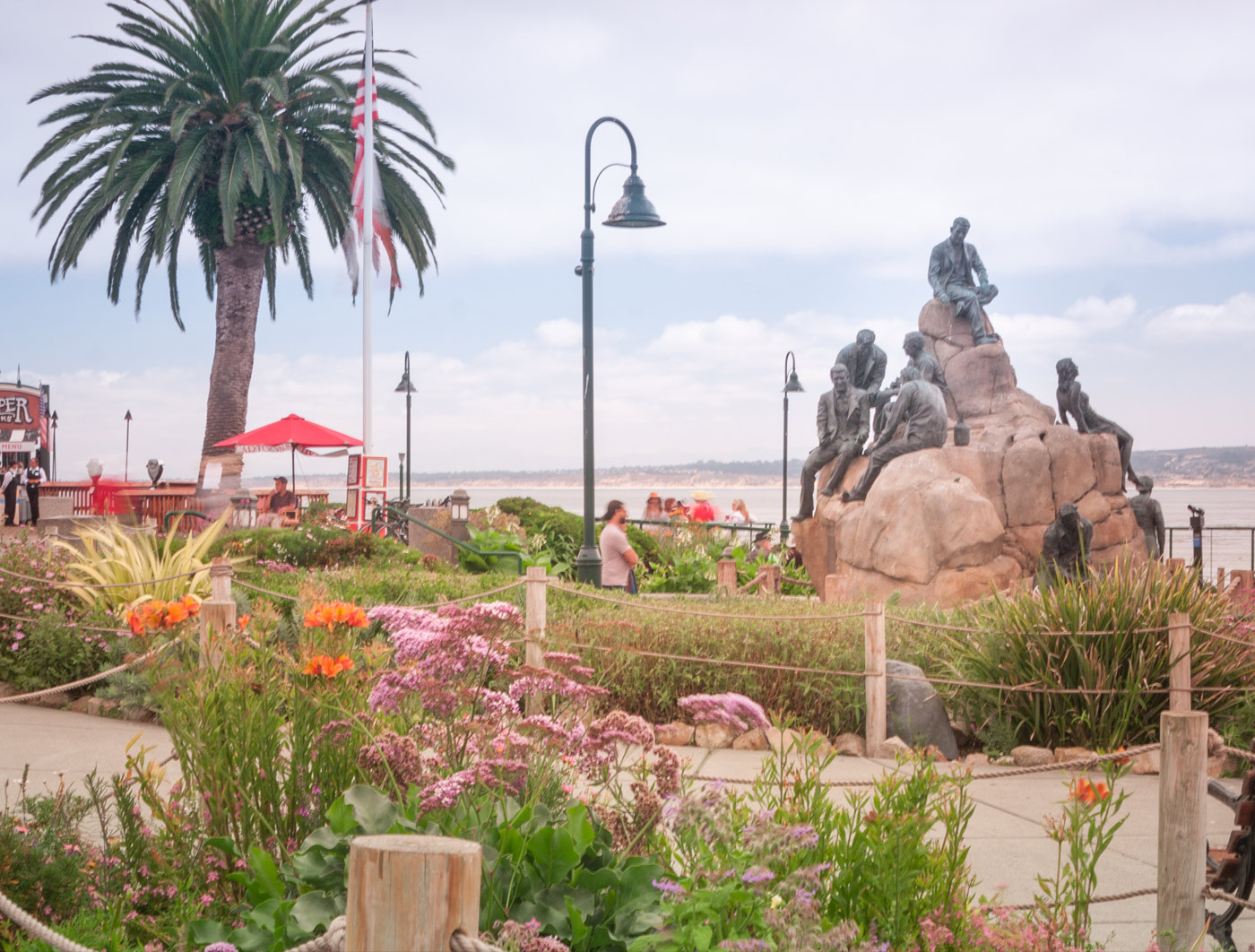
Our Story
John Steinbeck’s Cannery Row captured life on Cannery Row during its industrial heyday, but the story began long before canneries lined the famous street. The history of the Row is a fascinating tale, from Native American, Asian and European settlement, through the boom and bust of the whaling and sardine industries, to restoration and re-development. Past and present influence the architecture, cuisine and attractions as Cannery Row continues to celebrate the unshakable spirit on which it was founded.

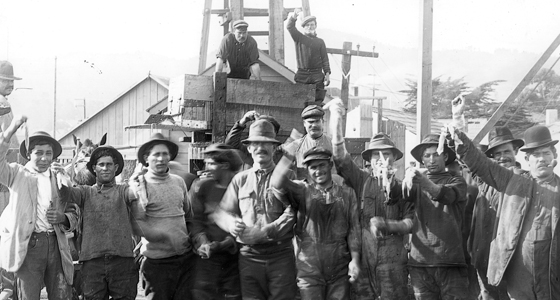
1770-1900
Monterey Bay has been home to many diverse cultures throughout history. First inhabited by Native Americans, then settled by the Spanish, it later became home to many Chinese, Italian, Portuguese and Japanese immigrants. Each culture left a unique mark on the history and legacy of Cannery Row, including the early success of the area’s squid, sardine, whale and salmon fishing industries.
1770-1900
Monterey Bay has been home to many diverse cultures throughout history. First inhabited by Native Americans, then settled by the Spanish, it later became home to many Chinese, Italian, Portuguese and Japanese immigrants. Each culture left a unique mark on the history and legacy of Cannery Row, including the early success of the area’s squid, sardine, whale and salmon fishing industries.
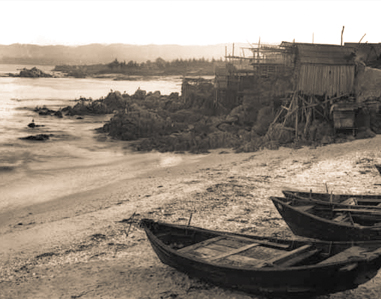
1851
Chinese fishing families crossed the Pacific in junks and settled at Point Ohlones ("China Point") and established Monterey's fishing industry. In 1927, the American Tin Cannery was constructed on this site and survives today as a retail and entertainment center.
1851
Chinese fishing families crossed the Pacific in junks and settled at Point Ohlones ("China Point") and established Monterey's fishing industry. In 1927, the American Tin Cannery was constructed on this site and survives today as a retail and entertainment center.
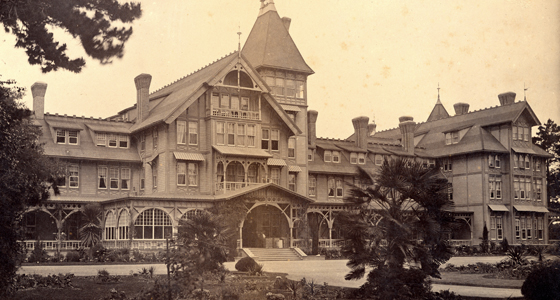
1880
The arrival of the Southern Pacific Rail Road and the construction of the Hotel Del Monte, the most lavish seaside resort in the world, opened the entire Monterey Peninsula to tourism.
1880
The arrival of the Southern Pacific Rail Road and the construction of the Hotel Del Monte, the most lavish seaside resort in the world, opened the entire Monterey Peninsula to tourism.
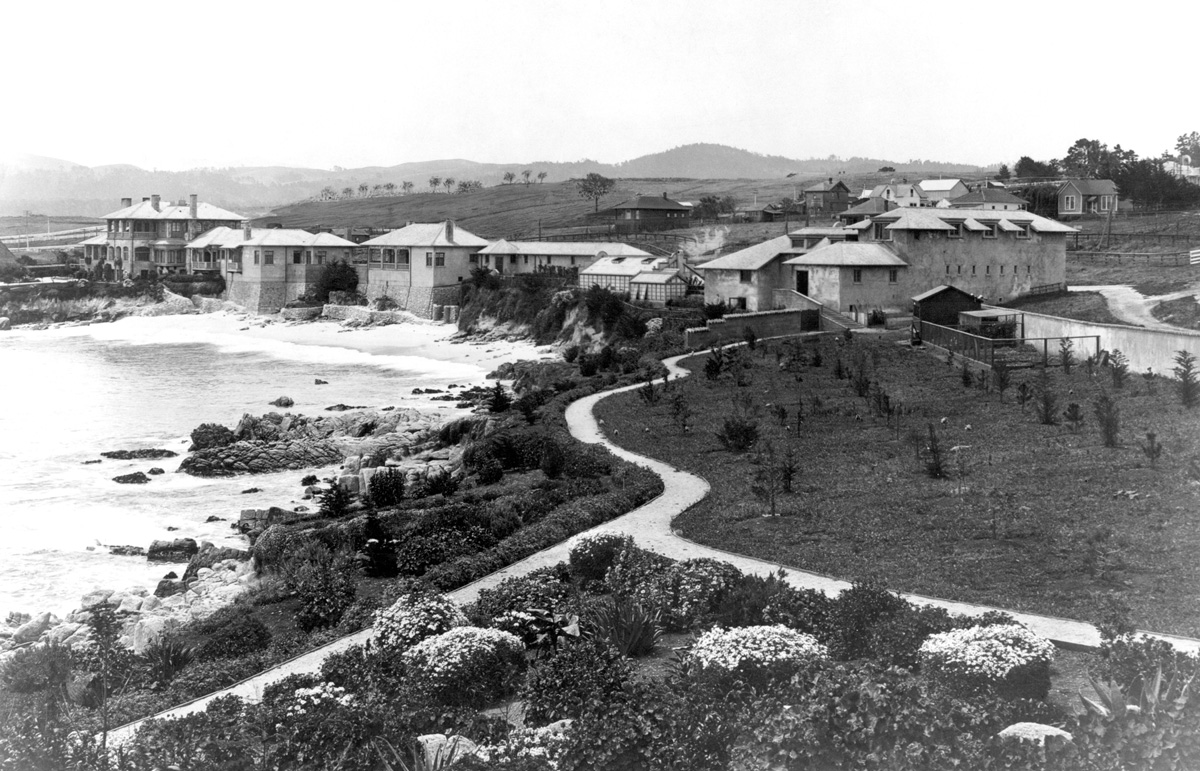
1901
The Tevis Estate, constructed in the elegant style of the era, on the shoreline outside Monterey intended for grand residential development, on a coastal road (part of the original 17 Mile Drive) which would become Cannery Row. Today, the Monterey Plaza Hotel & Spa offers visitors a chance to return to a more graceful era and experience a luxury resort designed to reflect the original Tevis-Murray Estate.
1901
The Tevis Estate, constructed in the elegant style of the era, on the shoreline outside Monterey intended for grand residential development, on a coastal road (part of the original 17 Mile Drive) which would become Cannery Row. Today, the Monterey Plaza Hotel & Spa offers visitors a chance to return to a more graceful era and experience a luxury resort designed to reflect the original Tevis-Murray Estate.
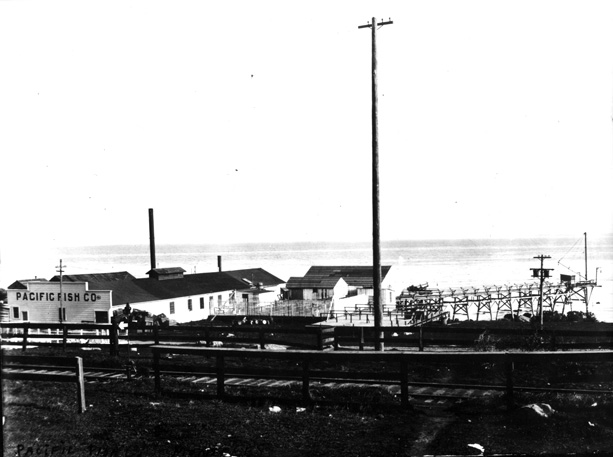
1902
Start of the Monterey canning industry: Booth Cannery in the Monterey harbor and the Japanese canning venture, Monterey Fishing & Canning Co., on the coastline near McAbee Beach.
1902
Start of the Monterey canning industry: Booth Cannery in the Monterey harbor and the Japanese canning venture, Monterey Fishing & Canning Co., on the coastline near McAbee Beach.
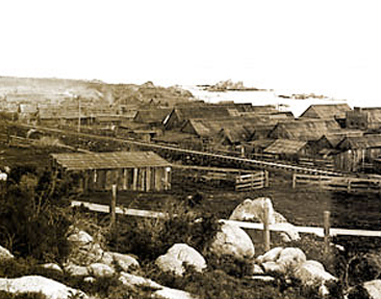
1906
The Chinese settlement at China Point burned for the third and final time, ending the Chinese as a major force in the Monterey fishing and canning industry. A smaller settlement was established on McAbee Beach in 1907.
1906
The Chinese settlement at China Point burned for the third and final time, ending the Chinese as a major force in the Monterey fishing and canning industry. A smaller settlement was established on McAbee Beach in 1907.
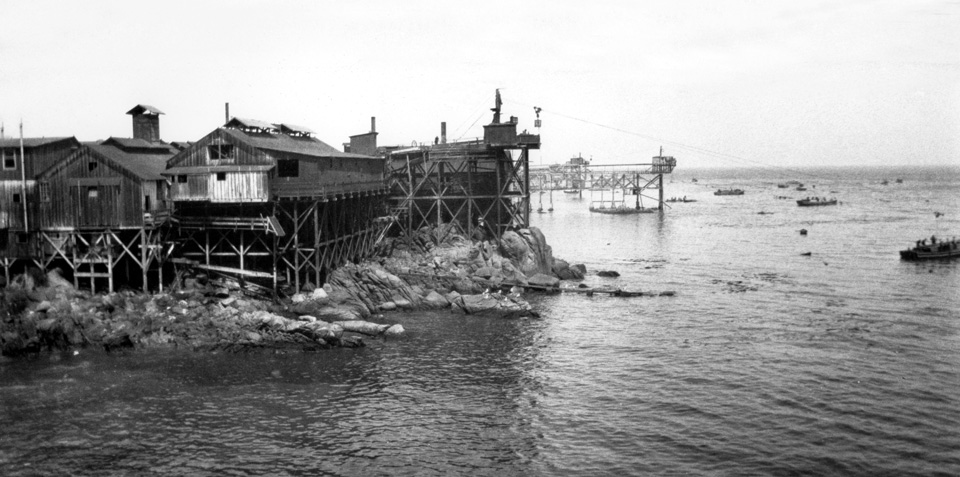
1916-1918
World War I cannery expansion driven by wartime demand: Hovden Food Products, Monterey Canning Company, Pacific Fish Company, Bayside Fish & Flour, San Xavier Canning Company, California Fisheries Co., and Pacific Packers/Great Western Sardine Co.
1916-1918
World War I cannery expansion driven by wartime demand: Hovden Food Products, Monterey Canning Company, Pacific Fish Company, Bayside Fish & Flour, San Xavier Canning Company, California Fisheries Co., and Pacific Packers/Great Western Sardine Co.
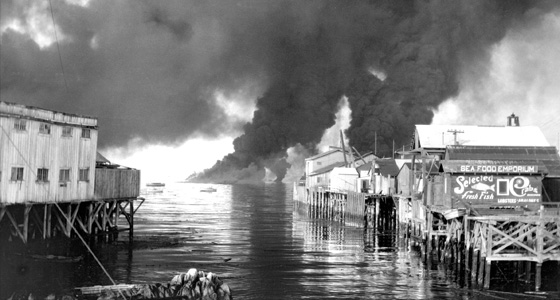
1924
Lightning struck large petroleum oil tanks above Cannery Row near the harbor. When they exploded, a river of flaming oil destroyed two canneries on the way to the sea, and burned on the bay, nearly reaching Fisherman's Wharf before wind and tide changed to save it.
1924
Lightning struck large petroleum oil tanks above Cannery Row near the harbor. When they exploded, a river of flaming oil destroyed two canneries on the way to the sea, and burned on the bay, nearly reaching Fisherman's Wharf before wind and tide changed to save it.
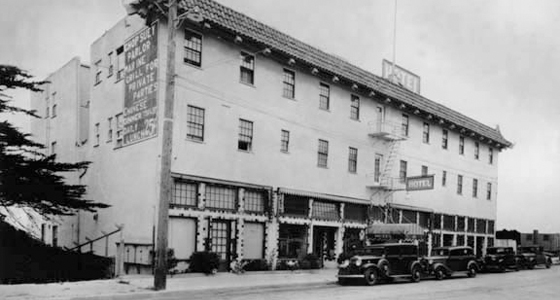
1927
The Wu family built the stylish Ocean View Hotel and its annex in 1929 as part of the Roaring Twenties expansion of Monterey - but on a street with a growing canning and fish meal industry becoming famous for its horrendous odors. Today, the Spindrift Inn is located on the site and reflects the charm of the original. Its annex now houses Cooper's Pub & Restaurant, a modern immigrant’s dream, offering authentic pub fare.
1927
The Wu family built the stylish Ocean View Hotel and its annex in 1929 as part of the Roaring Twenties expansion of Monterey - but on a street with a growing canning and fish meal industry becoming famous for its horrendous odors. Today, the Spindrift Inn is located on the site and reflects the charm of the original. Its annex now houses Cooper's Pub & Restaurant, a modern immigrant’s dream, offering authentic pub fare.
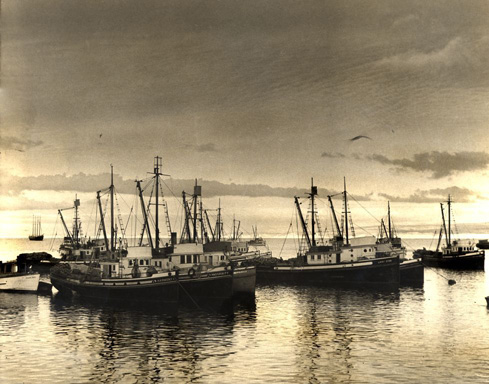
1928
Purse-Seiners, large and modern boats with nets a quarter mile long and two hundred feet deep, become the new "Wolves of the Sea" in the plunder of a seemingly inexhaustible supply of sardines. The technology to deplete the "Silver Tide" had arrived.
1928
Purse-Seiners, large and modern boats with nets a quarter mile long and two hundred feet deep, become the new "Wolves of the Sea" in the plunder of a seemingly inexhaustible supply of sardines. The technology to deplete the "Silver Tide" had arrived.
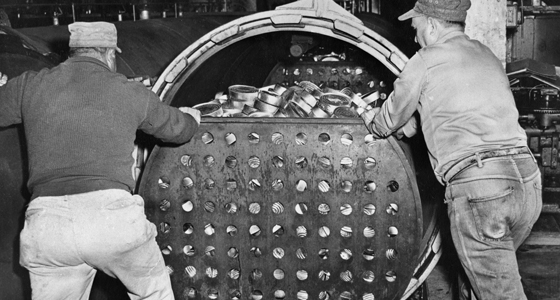
1930-1940
Reduction and the Depression: Fish or Jobs. Permitting huge quantities of edible sardines to become fish meal and fertilizer helped sustain an industry and a work force in Monterey through the Great Depression, but with disastrous consequences which would soon become evident. Two-thirds of a billion sardines a year were turned into fertilizer.
1930-1940
Reduction and the Depression: Fish or Jobs. Permitting huge quantities of edible sardines to become fish meal and fertilizer helped sustain an industry and a work force in Monterey through the Great Depression, but with disastrous consequences which would soon become evident. Two-thirds of a billion sardines a year were turned into fertilizer.
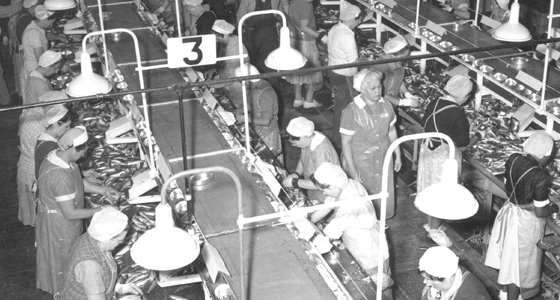
1941-1945
World War II cannery expansion: Monterey became "Sardine Capital of the World" as it fed a world at war with the plentiful and nutritious Monterey sardine. Within five years the industry would die on its waterfront for lack of sardines. The Monterey Cannery & Warehouse buildings, located at 700 and 711 Cannery Row, are now a place for visitors to find unique shops and restaurants.
1941-1945
World War II cannery expansion: Monterey became "Sardine Capital of the World" as it fed a world at war with the plentiful and nutritious Monterey sardine. Within five years the industry would die on its waterfront for lack of sardines. The Monterey Cannery & Warehouse buildings, located at 700 and 711 Cannery Row, are now a place for visitors to find unique shops and restaurants.

1945
Cannery Row by John Steinbeck told of the exploits of a band of bums on Cannery Row, surrounded by bordellos, flophouses, a Chinese grocery store and the laboratory of a man who, in reality, was quietly revolutionizing modern marine biology: Ed Ricketts - the "Doc" of John Steinbeck's Cannery Row.
1945
Cannery Row by John Steinbeck told of the exploits of a band of bums on Cannery Row, surrounded by bordellos, flophouses, a Chinese grocery store and the laboratory of a man who, in reality, was quietly revolutionizing modern marine biology: Ed Ricketts - the "Doc" of John Steinbeck's Cannery Row.
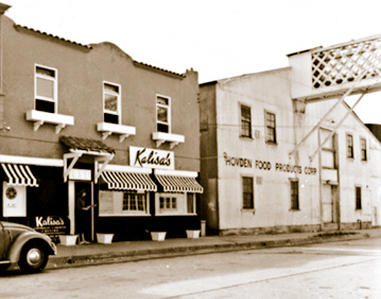
1953-1963
Early "New Row" business pioneers: restaurateurs Neil DeVaughn 1953; Kalisa Moore and her "La Ida Cafe" (in Cannery Row) 1958, and Dick O'Kane and his landmark Warehouse Restaurant 1963 - early leaders in a wave of change.
1953-1963
Early "New Row" business pioneers: restaurateurs Neil DeVaughn 1953; Kalisa Moore and her "La Ida Cafe" (in Cannery Row) 1958, and Dick O'Kane and his landmark Warehouse Restaurant 1963 - early leaders in a wave of change.
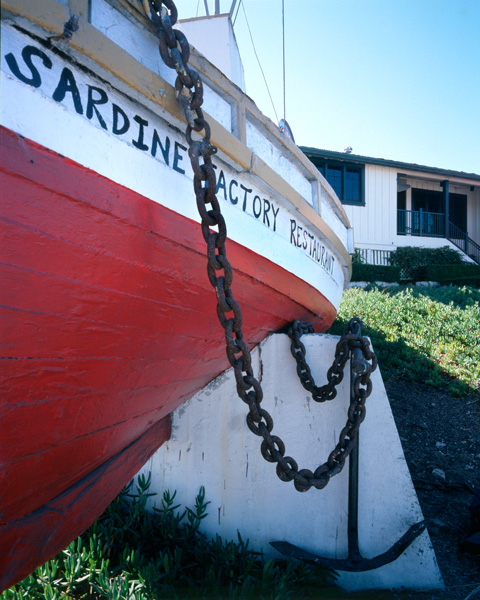
1968
Ted Balestreri & Bert Cutino, experienced Monterey restaurant managers open their own upscale venture "on the wrong side of the tracks" - Cannery Row - with the Sardine Factory Restaurant, starting today's "Restaurant Row."
1968
Ted Balestreri & Bert Cutino, experienced Monterey restaurant managers open their own upscale venture "on the wrong side of the tracks" - Cannery Row - with the Sardine Factory Restaurant, starting today's "Restaurant Row."
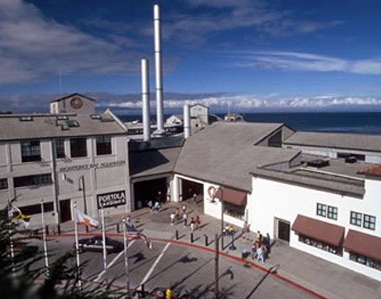
1984
The Monterey Bay Aquarium opens at the Hovden Cannery site, its approach to marine biology embracing the direction set in motion by Ed Ricketts, the fictional "Doc" in Steinbeck's Cannery Row works.
1984
The Monterey Bay Aquarium opens at the Hovden Cannery site, its approach to marine biology embracing the direction set in motion by Ed Ricketts, the fictional "Doc" in Steinbeck's Cannery Row works.
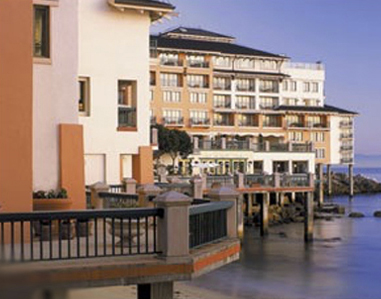
1985
The magnificent oceanfront Monterey Plaza Hotel opens on the Tevis Estate site in a return to the early grandeur and elegance of Ocean View Avenue, the original name of the street which, in 1958, was officially renamed Cannery Row.
1985
The magnificent oceanfront Monterey Plaza Hotel opens on the Tevis Estate site in a return to the early grandeur and elegance of Ocean View Avenue, the original name of the street which, in 1958, was officially renamed Cannery Row.


